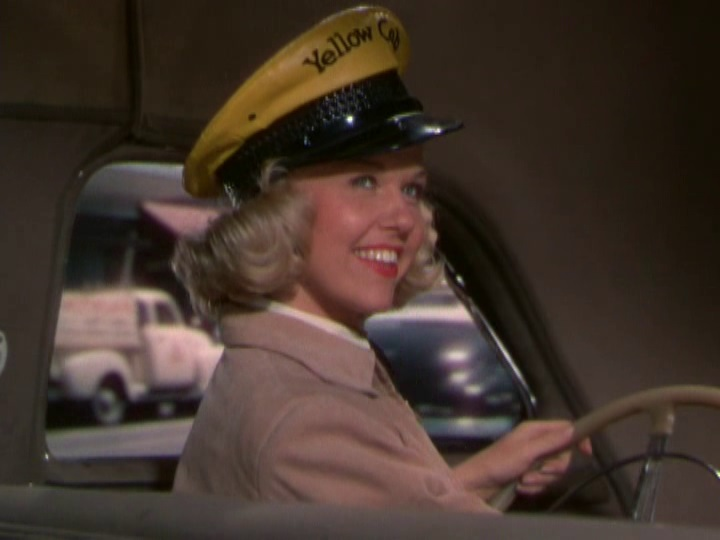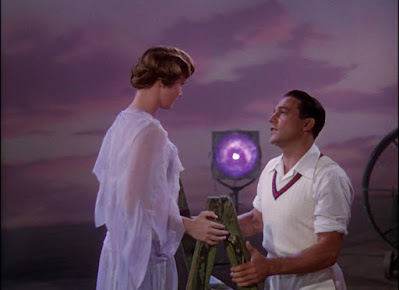Doris Day's Centennial: It's a Great Feeling (1949)
Hollywood loves to make fun of itself, and It's A Great Feeling is yet another vehicle for a studio system spoof. It's also a vehicle for Jack Carson and Dennis Morgan to be "the world's biggest hams," and a relatively-newfound singing sensation in her third film appearance - Doris Day!
It's also Doris's centennial this month, and I'm participating in Love Letters to Old Hollywood's blogathon to celebrate!
After her successful debut in Romance on the High Seas, Doris Day became everyone's favorite cinematic songstress. She was quickly re-teamed with Jack Carson for a second movie, and then a third when It's A Great Feeling was dreamed up. Originally it was a Morgan-Carson comedy under the potential names of Two Guys and a Gal, Two Guys of the Nineties, and Two Guys from Hollywood. (Dennis Morgan once said he never wanted to do another film with "Two Guys" in the title.)
The film itself resembles Doris Day's real journey from small-town singer to Hollywood waitress to big-screen star. It follows Judy Adams (Doris), an aspiring actress from Goerke's Corners, Wisconsin, as she's shoved around by directors and producers trying to make her a star (or so they say). It's A Great Feeling is stuffed with cameos, to add to the illusion and build up the studio's star-power reputation.
At the beginning of the film, we see a bunch of real-life directors from Michael Curtiz to Raoul Walsh. Each one is refusing to helm a new picture called Mademoiselle Fifi because Jack Carson (playing himself) is starring, and they want nothing to do with the "world's biggest ham". Eventually they decide he'll have to direct it himself. Meanwhile, Judy Adams delivers lunch to Carson in his dressing room, and proceeds to lock the door and force him to watch her audition. She performs an incredibly overdramatic monologue, which doesn't impress Carson - but it does give him an idea. He sends Judy, dolled up in mourning attire, to Dennis Morgan's dressing room. She pretends to be Mrs. Jack Carson, who will lose her house, her car, and potentially her baby if he doesn't make the picture. Shocked and compassionate, Morgan agrees to do Mademoiselle Fifi - except he figures out the ruse, and Carson tries to pay Judy off with 5 dollars, so she leaves disappointed at both stars.
Trying to forget the poor girl they tricked, Morgan and Carson go looking for a female lead. They can't find anyone willing to be directed by Carson, and when they offer the role to Jane Wyman (a cameo!) she faints. Desperately, Morgan suggests using an unknown actress - like, perhaps, Judy Adams? The only problem is that she's on her way back to Goerke's Corners, feeling used by the Hollywood bigwigs. The two men follow her to the train station, where we watch an excruciating five minutes of "comedy" in which the train conductor rifles through books trying to find information about the Goerke's Corners train. We get it, it's a small town!
The best part of the train station scene is the Danny Kaye cameo, in which he struggles to carry a million suitcases while convincing Judy she should stay in Hollywood (wordlessly, because his tickets are in his mouth). This is a theme throughout the movie - the cameos really are the best part. The little "hey, I know them!" moments are what keeps It's A Great Feeling fun during its often-slow scenes - especially because Doris doesn't get nearly enough singing time.
Star-struck, ever-optimistic Judy agrees to give fame another chance, and Morgan and Carson quickly take her to a fancy dress shop so she can look the part. Who's at the dress store? Joan Crawford, of course. Joan's cameo is easily one of my favorite parts of the movie. Launching into a melodramatic speech about how Morgan and Carson are taking advantage of a young girl, she slaps them both in the face and then proclaims, "I do that in all my pictures!"
Morgan and Carson sneak Judy into the studio (with the help of Edward G. Robinson) for a screen test as Mademoiselle Fifi. They dress her up in a crazy costume and have her lip-synch "Big Fat Lie." When Arthur Trent watches the screen test, however, Morgan's voice has been dubbed on Judy's and vice versa, the lighting is going crazy, and the screen starts spinning and flashing in and out - in short, it's a nightmare.
On the train home, Judy has a terrible nightmare - literally and figuratively. She's plagued by visions of Morgan and Carson (who are also magazine ads?) and thrown into a dream sequence of lovers' quarrels, fights, chairs being smashed, guns firing, and people falling down stairs - and the whole time she's performing "There's Nothing Rougher Than Love".
Judy wakes up and wanders around the train, where she finds a seat and sings a reprise of "Blame My Absent-Minded Heart". It's one of the loveliest scenes in the movie - something about the train setting, the puffy pink robe, the reprieve from the chaotic dream sequence - and Doris being really featured, at last!






















I feel the same way about this film. It's fun and cute (and I just love those cameos, especially Errol Flynn's!), but it's not one I revisit often. Dennis Morgan and Jack Carson are a great team, but their schemes do start to get a little annoying as the film goes on.
ReplyDeleteThanks for contributing to my event!
Hello!
ReplyDeleteThis movie looks so charming, thanks for highlighting it. I'm absolutely loving all those cameos and look forward to seeing it!
I'm also glad I discovered your lovely blog recently and anticipate going through your posts as I enjoyed this one very much.
P.S. I tagged you for the 5 Classic Movies I Would Take to a Desert Island challenge! If you're interested in taking a look, I'll leave the link for you below :)
https://theclassicmoviemuse.wordpress.com/2022/04/01/5-classic-movies-i-would-take-to-a-desert-island-the-pick-my-movie-tag/
Delightful comedy! I loved the cameos (Joan Crawford's bit was my favorite).
ReplyDeleteI'm another one who doesn't watch this film regularly, but when I do, I absolutely adore it. The cameos are so much fun, especially Errol Flynn's which is one of the best parts of the film. It's been 3-4 years since I've seen this one, and you've got me jonesing to see it again.
ReplyDeleteOoh, Doris Day and Dennis Morgan would sound so great together. I'm going to have to look for this one.
ReplyDelete